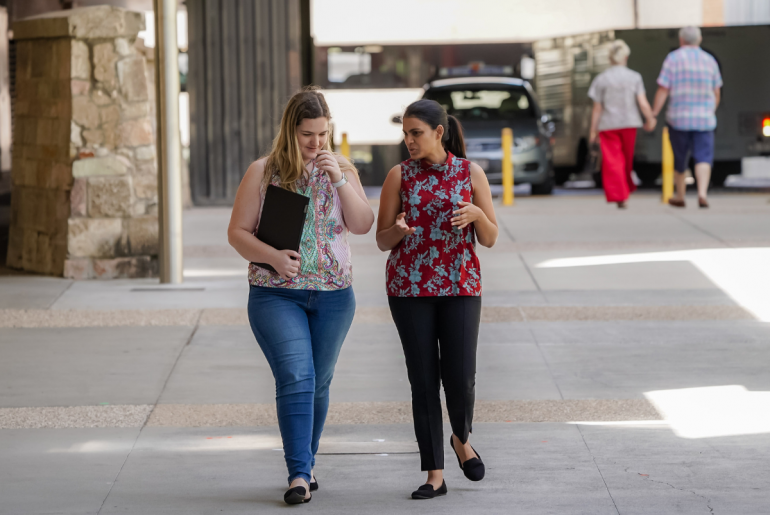The following article, written by Gautam Ramesh, Andrea LaCroix, and John Bellettiere, was originally published on February 25, 2019 in The Conversation. You can read the original article here. Too much sitting has long been criticized for contributing to premature mortality, Type 2 diabetes, and a host of other illnesses. In a new study of 5,638 women, we looked at how sedentary behavior was related to future cardiovascular disease (CVD). The results showed that those who were most sedentary had the highest risk for having a future CVD event. We also found that women who most often interrupted their sedentary time to stand up and move had significantly lower risk for CVD than women who sat for long stretches of time without standing up. The results persisted even after accounting for other common factors linked with CVD such as age, overall health, blood pressure and cholesterol. CVD includes heart attacks, strokes, heart failure and other diseases concerning the heart and blood vessels. It is the leading cause of death in the U.S., accounting for 1 in 4 deaths annually. Our findings, along with the research discussed below, provides strong evidence that sitting too much is an important factor to consider for heart…
Global Action Plan on Reducing Physical Inactivity
The World Health Organisation (WHO) has recently released a Global Action Plan on physical activity with the aim of reducing physical inactivity by 10% by 2025, and by 15% by 2030. To support this goal they have developed 4 main objectives: Create active societies: “Create a paradigm shift in all of society by enhancing knowledge and understanding of, and appreciation for, the multiple benefits of regular physical activity, according to ability and at all ages.”1 Create active environments: “Create and maintain environments that promote and safeguard the rights of all people, of all ages, to have equitable access to safe places and spaces, in their cities and communities, in which to engage in regular physical activity, according to ability.”1 Create active people: “Create and promote access to opportunities and programmes, across multiple settings, to help people of all ages and abilities to engage in regular physical activity as individuals, families and communities.”1 Create active systems: “Create and strengthen leadership, governance, multisectoral partnerships, workforce capabilities, advocacy and information systems across sectors to achieve excellence in resource mobilization and implementation of coordinated international, national and subnational action to increase physical activity and reduce sedentary behaviour.”1 The reduction of sedentary behaviour is included in objective…
What is the link between Stress, Team Cohesion, and BeUpstanding™?
At team BeUpstanding™, we are not only interested in how our program impacts on raising awareness, building culture, and changing behaviour to support workers to stand up, sit less, and move more, but also on its broader impact on health, productivity and wellbeing. The following blog is written by Jemieca Loeffler who undertook her honours with the BeUpstanding™ team here at the University of Queensland. She worked with some of our amazing champions and teams taking part in BeUpstanding™ to find out in a bit more detail if there was any impact of the program on occupational stress and group cohesion. What she found was that the more stressed employees were and the more cohesive they felt with their team, the less time they spent sitting at work and the more likely they were to engage in BeUpstanding™. Sound interesting? Read below to find out more! Some background info As we know, prolonged sitting can be detrimental for our health, and many of us fall victim to this public health concern through our jobs. A study by Thorpe et al. showed that call centre workers, in particular, are at highest risk of sedentariness, spending up to 90% of their work day sitting,…
You should stand in meetings – don’t worry about what others might think
The following article, written by Benjamin Gardner, Lee Smith, and Louise Mansfield, was originally published in The Conversation on July 2, 2018. Standing in meetings may be good for our health, but it can also make those that are standing feel self-conscious, anxious about how others perceive them, and disengaged from the meeting. These findings, taken from our recent study, suggest that efforts to encourage office workers to sit less and move more must acknowledge the realities of the workplace that conspire to keep people chained to their seats. Sitting has been linked to adverse health outcomes, including increased risk of obesity, heart disease, some cancers, and poorer mental health. While some evidence suggests that the harms of sitting can be offset by at least one daily hour of moderate physical activity, this seems an unrealistic target. Most of the UK population fails to meet physical activity recommendations and spends prolonged periods sitting. Office workers, who make up half of the UK workforce, are particularly inactive. Our 2015 study of 164 London workers found that, on workdays, they sat for 10.5 hours of the 16 hours they spent awake. Breaking up sitting frequently with periods of standing and associated light activity can have important health…
Is sitting bad for us? There’s good and bad news
The following article, written by Professor David Dunstan – one of our BeUpstanding Academic team members – was originally published in The New Daily on June 25, 2018. As you read this, what are you doing right now? If you’re sitting down, scientists have some good and bad news. First, the bad news. The way most adults work has steadily changed over recent decades. While in many ways our workplaces are ‘safer’ from an occupational hazards perspective, it is now encouraged or even demanded that we spend large portions of our day sedentary (seated) – usually with our eyes glued to some type of screen. While this is now the new norm, we simply weren’t built for such a stationary existence and, unsurprisingly, accumulating scientific evidence demonstrates that exposure to high amounts of sitting significantly increases the risk of premature death, heart disease and type 2 diabetes. Yes, you can help to reduce the risks associated with too much sitting if you undertake daily exercise, but unfortunately science tells us the best estimate of the amount of exercise required is equal to about 80 to 90 minutes per day of moderate-intensity activities (such as brisk walking) or 40 to 45…
Motivational Email Tips
Stuck for ideas? Are you looking for email tips to motivate your team to stand up, sit less, and move more? If so, read on because we have some topic ideas and tips to help you keep your team excited! Colors, images, tone of voice, and content can all be used to make your emails motivational. If you already have an idea of what will motivate your team, go for it! The suggestions below are simply some topic ideas that you are welcome to use. Current events To keep your emails engaging and relevant, try to tie current events into the theme of your email. You can do this by mentioning seasons, holidays, or sporting events! For example, you could use the Commonwealth Games as motivation: “Inspired by the Commonwealth games? Consider trying a new activity or revisiting one you used to play. Maybe you could try a race walk to your next meeting! You don’t need to be training for Birmingham 2022 to get the benefits out of sitting less and moving more.” Activity outside of work Now that staff are getting used to more activity at work, this is a good opportunity to encourage physical activity out of office hours. Activity outside of work can include moderate…
BeUpstanding™ Champion – What’s That? And Can I Be One?
What’s a champion? A BeUpstanding™ workplace champion is the primary person who runs the BeUpstanding™ Program in their workplace. They get access to the BeUpstanding™ Champion Toolkit which provides free resources and a step-by-step easy to follow guide to help them run the program. The toolkit provides resources such as free posters, videos, and email templates to help create culture change in the workplace. From over 10 years of research, we know that in order to create change it is key to have a workplace champion leading the way. After all, one person really can make a difference! Who can be a champion? ANYONE who has the desire and capacity to run the BeUpstanding™ Program in their workplace can be a BeUpstanding™ champion! No, you do not have to be CEO or management to become a champion. As long as you have management approval, a passion to create a healthier work environment for you and your colleagues, and capacity to run the program, you’re good to go! We have had a wide variety of different champions from all types of workplaces sign up. You can check out the workplace characteristics here. Just to give you an idea… We have had champions from a…







